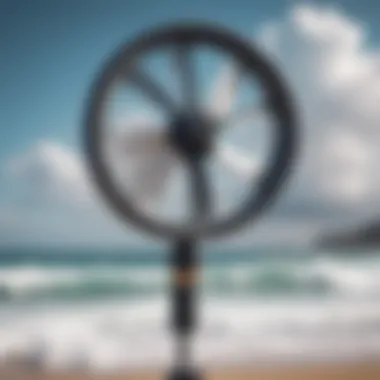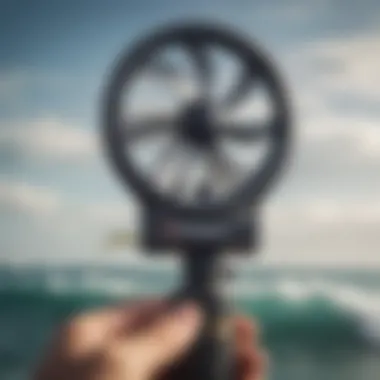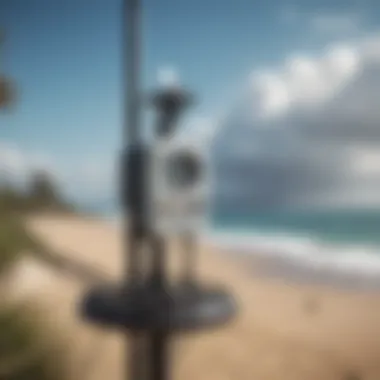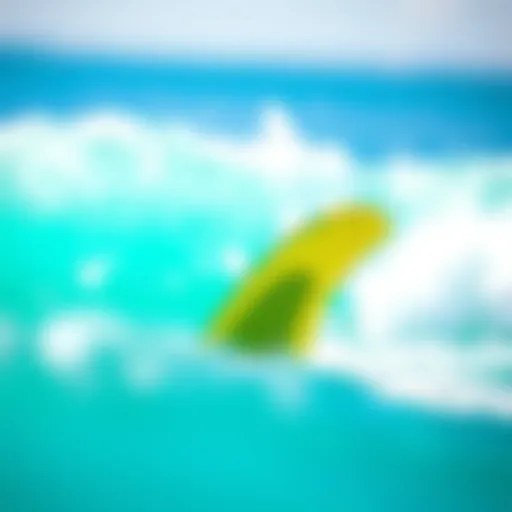Understanding Anemometers for Surfers' Weather Insights


Intro
When it comes to riding the waves, surfers are not just after the thrill; they are also in constant tune with the whims of the weather. Among the most significant tools at their disposal is the anemometer—a device that helps them gauge wind speed and direction. This piece of equipment isn't just for meteorologists or seasoned sailors; it's a game changer for anyone who wants to make the most of their surfing experience. By understanding wind patterns and how they affect surf conditions, surfers can choose the right time to hit the water and optimize their rides.
Diving into the world of anemometers is akin to cracking open a treasure chest full of knowledge. With varying types and advanced technology now on the scene, from handheld devices to sophisticated automated systems, there are plenty of options available to surfers eager to up their game. Let’s sift through how these fascinating instruments work and why they are essential, especially for those prowling the coastline, ready to catch the next big wave.
Prolusion to Weather Instruments
Understanding weather instruments is crucial for anyone who spends time outdoors, especially surfers. The changing weather can dramatically affect the surfing experience, making it paramount for surfers to know what to expect. Even small shifts in wind direction or speed can mean the difference between catching a perfect wave or struggling against choppy waters.
Weather monitoring enables surfers to make informed decisions, helping them stay safe while optimizing their time on the water.
The Importance of Weather Monitoring
Weather monitoring not only affects safety but also significantly enhances the overall surf experience. Knowing the weather patterns helps surfers choose the right times for riding waves, making it essential for both recreational and competitive surfers. Strong winds can create ideal conditions for certain types of waves, while calm days might suit beginners better. With reliable weather data, surfers can plan trips more effectively, ensuring they're not stuck at the beach on a flat day.
- Safety First: Lack of wind can lead to risks like rip currents, while high winds may create dangerous surf conditions. Monitoring these factors keeps surfers safe.
- Time Management: Surf forecasting enables surfers to get the most out of their time, maximizing enjoyment and wave-riding opportunities.
- Community Engagement: Many surfers share weather insights, contributing to a community that thrives on collective knowledge.
Overview of Various Weather Instruments
Exploring various weather instruments equips surfers with the knowledge they need. Here are a few vital instruments:
Barometer
Barometers measure atmospheric pressure, which can indicate upcoming weather changes. High pressure generally brings sunny skies, while low pressure often leads to storms.
- Key Characteristic: The ability to predict weather changes is invaluable. Understanding these shifts helps surfers choose optimal times for their sessions.
- Unique Feature: The barometric tendency, or how pressure changes over time, can forecast gales or calm waters in the coming hours.
- Advantages: They're useful for long-term surf planning. But, they don’t measure wind speed, which is an integral component for surfers.
Hygrometer
The hygrometer measures humidity, which might not seem directly relevant to surfing, but it plays a role. High humidity can create more comfortable conditions, while lower humidity levels can signal dry and windy weather.
- Key Characteristic: It affects wave conditions and the overall surfing experience. High humidity often means a lack of heat, making it more pleasant to enjoy those long sessions.
- Unique Feature: Some hygrometers can also predict precipitation, letting surfers know if rain is on the horizon.
- Advantages: While essential, it's not the go-to tool for immediate surf-related decisions as it doesn’t provide specific wind or wave data.
Anemometer
An anemometer measures wind speed and is indispensable for surfers. It offers precise data regarding the wind’s impact on surf conditions, which is key for planning a surf outing.
- Key Characteristic: Wind speed affects surf quality; knowing this can drastically improve the surf forecast accuracy.
- Unique Feature: Unlike other instruments, an anemometer provides real-time wind readings, which can be crucial as conditions can change rapidly.
- Advantages: It’s tailored for surfers, offering relevant data needed to make informed decisions. However, relying too much on one reading can be misleading, as wind patterns can change quickly in coastal areas.
In summary, weather monitoring goes beyond just keeping an eye on the sky. It requires understanding a variety of instruments, each contributing unique insights that surfers can leverage to enhance their experience. Each tool has its own strengths and weaknesses, so being knowledgeable about them all can help surfers ride the waves like pros.
Anemometer: Definition and Purpose
An anemometer is more than just a fancy gadget for weather buffs or scientists; it serves as a pivotal tool in measuring wind speed and sometimes direction. Its relevance ripples through various activities, including surfing, where understanding wind conditions can be the difference between an exhilarating ride and a disastrous wipeout.
Understanding Wind Measurement
Wind measurement is, at its core, a study of the invisible forces that influence our environment. Without proper instruments like anemometers, gauging these factors becomes like trying to hit a moving target in the dark. With accuracy as the main objective, anemometers capture data on wind velocity by employing several mechanisms to determine how fast the air is moving.
There are different kinds of anemometers, each with its machet of applications:
- Cup Anemometers, which rotate as the wind hits them, giving a direct measure of wind speed.
- Vane Anemometers that use blades to detect changes in airflow direction.
- Hot Wire Anemometers that calculate speed based on the cooling effect of wind on a hot wire.
- Digital Anemometers that provide instant readouts, beneficial for real-time monitoring.
This comprehensive approach paves the way for effective forecasting, essential for activities like surfing, kiteboarding, and sailing. By getting a grip on wind forces, surfers can better predict when conditions will be just right for riding those perfect waves.
Critical Role for Surfers
For surfers, wind isn’t just a meteorological phenomenon; it’s a direct factor that influences wave formation. Many know that powerful winds create strong waves, but understanding the nuances can elevate your surfing experience from ordinary to extraordinary.
Wind affects ocean surface conditions, driving swells across vast distances, which surfers eagerly await. Here’s how understanding anemometer data translates into real-world benefits:
- Safety: Knowing wind speeds helps surfers identify potentially hazardous conditions—too strong of winds can result in dangerous waves.
- Timing: Surfers can plan their outings around favorable wind patterns that provide the best surfing conditions.
- Performance: With accurate wind speed data, surfers can adapt their techniques and boards accordingly. Higher winds could suggest a need for a smaller board or different maneuvers to ride successfully.


"Not all surfers are ready for the wild winds; it's vital to know your limits and use tools like anemometers to gauge conditions."
Moreover, understanding how wind interacts with water gives surfers an edge. It’s not just about being on the right wave at the right time, but also about having the knowledge to interpret wind behavior in a way that enhances enjoyment and minimizes risks.
Types of Anemometers
When it comes to wind measurement, selecting the right kind of anemometer is vital. Each type offers distinct advantages and precision levels tailored to different needs and environments, especially for surfers keen on reading the wind's whisper.
Cup Anemometers
Cup anemometers are perhaps the most recognizable type of wind measuring devices. They typically consist of three or four cups mounted on horizontal arms, revolving around a vertical shaft when the wind blows.
- Advantages: The simplicity of the design allows for straightforward maintenance and high durability. Cup anemometers can provide consistent readings in various wind conditions, making them suitable for both amateur and professional setups.
- Considerations: While robust, they can be slower to respond to sudden changes in wind speed compared to other types. This lag time might affect surfers relying on real-time data, particularly when conditions shift rapidly.
"Cup anemometers have been the standard for many years, especially near coastal areas where surfing thrives. They offer reliability that surfers have learned to trust."
Vane Anemometers
Vane anemometers, often equipped with a small propeller, aim to measure wind speed and direction simultaneously. This dual functionality makes them particularly useful for surfers who need to understand how wind impacts waves.
- Advantages: With their integrated design, they respond quickly to changes in wind speed and direction. This feature proves essential for surfers planning their sessions based on real-time conditions.
- Considerations: Such devices can suffer in extreme weather, leading to potential inaccuracies. Therefore, choosing high-quality models becomes crucial, especially for regular users.
Hot Wire Anemometers
Hot wire anemometers are a bit more specialized, utilizing a heated wire that cools down as wind passes over it. The drop in temperature helps gauge the wind speed accurately.
- Advantages: These anemometers offer very sensitive measurements, making them ideal for use in controlled environments or precise scientific settings. Their ability to measure low wind speeds can also be beneficial in scenarios where conditions might not be conducive to larger devices.
- Considerations: However, hot wire anemometers may not be the best choice for outdoor surfers. They are more fragile and can be less reliable in rugged conditions typical of the ocean.
Digital Anemometers
Digital anemometers have gained popularity due to their convenience and advanced features. Equipped with electronic sensors, they can present data instantly on an LCD screen, often including additional measurements such as temperature, humidity, or even averages over specific intervals.
- Advantages: These devices are straightforward to read, offering an array of features that can enhance a surfer’s understanding of the weather. Many digital models are pocket-sized, making them portable for those who travel or surf at different locations.
- Considerations: Dependency on batteries and electronic components means they can sometimes be less reliable in severe conditions. Regular maintenance and checks on battery life become essential for consistency.
As surfers look to optimize their experience and safety, understanding these types of anemometers will guide them in choosing the right tool for their requirements.
How Anemometers Work
Understanding how anemometers function is crucial for surfers and anyone involved in weather-dependent activities. These devices measure wind speed and, at times, direction, enabling users to predict sea conditions, optimize their performance, and even ensure their safety while out on the water. When surfers grasp the way these instruments operate, they can make better decisions regarding when and where to ride the waves, significantly enhancing their overall experience.
Principle of Operation
An anemometer works based on relatively straightforward principles of physics. The core function hinges on its ability to translate the motion of the wind into quantifiable data. The most common type, the cup anemometer, consists of three or four cups mounted on horizontal arms. When the wind blows, it pushes the cups, causing them to rotate. The faster the wind, the quicker they spin. By measuring the rotation speed, the anemometer calculates wind speed using the following formula:
- Wind Speed (m/s) = (rotation rate of cups in RPM) × (constant factor)
Digital anemometers often utilize similar concepts but employ modern sensors to measure airflow and convert it into electronic signals, displaying the readings on a screen. In either case, the primary goal remains the same: accurate wind speed measurements, vital for surfers who rely heavily on wind conditions for optimal surfing experiences.
Data Collection Methods
Data collection methods vary significantly between different types of anemometers, and understanding these distinctions is important for surfers.
- Mechanical Collection:
Traditional cup anemometers use mechanical means to gather data. These devices utilize gears and other components to translate physical wind movement into numerical output. It’s straightforward and effective but may require calibration and maintenance, particularly in harsh environments. - Digital Sensors:
More advanced devices utilize hot-wire or ultrasonic sensors. Hot-wire anemometers measure the cooling effect of airflow over a heated wire to determine speed. Conversely, ultrasonic anemometers gauge the time it takes for sound waves to travel between sensors, which can effectively provide data on both speed and direction at the same time. These methods are generally more precise and produce quicker results than traditional mechanical styles. - Mobile Applications:
In today’s tech-savvy world, anemometer data can also be collected through mobile applications connected to portable anemometers. Surfers can simply check their smartphones for instant wind speed readings while on the beach. This convenience allows for quicker decision-making about surf conditions.
"Understanding the operational principles of anemometers is akin to having a secret sauce for navigating the waves; it empowers surfers to choose their moments wisely."
Interpreting Wind Speed Data
Understanding how to interpret wind speed data is like learning to read between the lines of nature’s book. For surfers, this goes beyond just numbers on a screen; it presents an opportunity to align with shifting wave patterns and channel the ocean’s energy.
Understanding Wind Speed Measurements
Wind speed measurements are an essential part of surfing. Typically expressed in miles per hour (MPH) or meters per second (m/s), these data help surfers gauge how the wind will affect the waves. A wind speed of 5 to 12 MPH can generate fun, rideable waves, while anything above 30 MPH might create chaotic conditions.


Key Points on Measuring Wind Speed:
- Units of Measurement: Familiarizing oneself with different units is crucial. MPH and m/s are most common in surfing communities.
- Measurement Consistency: Regularly checking the same measurement over time gives a clearer picture of trends in local wind conditions, helping surfers identify good days to hit the water.
- Understanding Variability: Wind speeds can change rapidly. A slight shift can transform conditions dramatically, hence keeping an eye on the forecasts and using anemometers can be a game-changer for any surf session.
Effective Usage for Surf Conditions
A surfer’s effectiveness in choosing when and where to ride is often tied to their understanding of wind conditions. For instance, knowing the optimal wind direction can tell you whether the waves will be smooth or choppy. Here’s how surfers can capitalize on wind data:
- Directional Impact: Winds from the land, known as offshore winds, generally produce better conditions by grooming the waves. Conversely, onshore winds can make the sea messy, affecting rideability. Thus, as a surfer, knowing the wind direction is half the battle.
- Timing Your Session: Being aware of peak wind times aids in planning. Early morning often features lighter winds, while afternoons can offer stronger gusts.
- Safety Considerations: High winds can lead to dangerous surf conditions. Therefore, proper interpretation and understanding of wind speed data can enhance personal safety during surf outings.
"A good surfer doesn’t just ride waves; they ride the winds too."
In summary, interpreting wind speed data allows surfers to not only enhance their experience but also to approach each session with a sense of preparedness. Understanding wind speed measurements and having an effective plan for utilizing that information can mean the difference between a lackluster day at the beach and a thrilling ride. Thus, ensuring proper interpretation of wind speed data is paramount for anyone serious about embracing the surf lifestyle.
Anemometers in Surf Forecasting
Anemometers play a pivotal role in surf forecasting, as they help surfers, forecasters, and weather enthusiasts decipher the relationship between wind patterns and wave conditions. By understanding how wind influences surf, one can grasp why having accurate anemometer readings is crucial for planning a successful session at the beach.
Wind acts as a driving force for the formation and breaking of waves. When wind blows across the surface of the ocean, it transfers energy to the water, creating waves. The speed and direction of the wind can significantly affect the quality of surf, whether it’s powering up those perfect sets or flattening out the surface with unwanted choppy conditions. Thus, knowing what the wind is doing helps surfers choose the right time to hit the water. The difference can be between a thrilling ride or a frustrating outing.
The Link Between Wind and Waves
The correlation between wind and waves is essentially a dance, where both elements continuously interact. When wind speed increases, the size and quality of waves generally improve. Strong winds can generate sizable swells, which are particularly appealing for more adventurous surfers. Conversely, too much wind can create a messy surface which may ruin the experience entirely. For surfers, understanding this link translates into benefits such as better assessment of surf conditions.
To put it plainly:
- Light Wind: Usually leads to cleaner, more organized waves that can make for excellent riding conditions.
- Moderate Wind: Can produce some nice sizes for experienced surfers, but it may come with chop.
- Strong Wind: Generally unfavorable, producing turbulent waves that are challenging to ride, unless you’re looking for a wild ride.
Waves come in different sizes and forms, influenced distinctly by the wind's speed and direction. A competent surf report links wind conditions with swell size and direction, enabling surfers to make informed choices about when and where to paddle out.
"Wind is the architect of waves, and understanding it helps you catch the perfect ride."
Integrating Anemometer Data in Surf Reports
Integrating anemometer data into surf reports has become an integral part of modern surfing culture. In the fast-paced world of surfing, where conditions can change by the minute, having reliable wind speed readings can greatly enhance a surfer's decision-making process.
When surf reports include anemometer data, they provide a comprehensive picture of the forecast. For example, surfers often look for specific metrics like:
- Wind Speed: A crucial number that informs surfers about how rough or smooth the surf might be.
- Wind Direction: Helps in understanding where the waves will break, enabling surfers to choose the best spots.
- Trends Over Time: Observation of how wind conditions have varied throughout the day can indicate upcoming changes and affect their surf plan.
Moreover, technology advancements have improved accessibility to this data. With mobile apps and websites displaying real-time wind measurements from anemometers, surfers have better tools at their disposal for planning their sessions.
The blend of tradition and technology, especially when harnessing anemometer data, supports the idea that informed decision-making leads to enhanced safety and performance out on the waves. All thanks to those nifty little devices bustling away in the background!
Selecting the Right Anemometer
Choosing the right anemometer is crucial for surfers who want to maximize their time on the waves. This decision involves considering a few specific elements that can significantly impact the accuracy and usefulness of wind measurements. The right device not only helps in understanding surf conditions but also enhances safety.
Recognizing that not all anemometers are created equal is the first step. Surfers need to look for features that cater to their unique circumstances, including mobility, ease of use, and of course, precision in wind measurement. A surfer might overlook these details, thinking any anemometer could do the job, but that’s simply not the case.
Moreover, a good anemometer translates into smooth surfing experiences and better decisions on when to ride the waves. An ill-chosen instrument can lead to misunderstandings about the wind's speed and classification.
Key Features to Consider
When shopping for an anemometer, here are some key features that ought to be considered:
- Wind Speed Range: It’s vital to check how fast the device can accurately measure wind speed. Ideally, it should measure low wind speeds (around 1-30 mph) but also capture higher speeds depending on local conditions.
- Portability: For surfers, lightweight, compact devices are essential. An anemometer that's easy to carry ensures that it won't become a burden during travel.
- Data Display: Consider whether you want a digital reading or a simple dial. Digital screens often provide additional information but may be harder to read in bright sunlight.
- Durability and Weather Resistance: The ocean can be rough, and equipment can get wet. Look for models built to withstand moisture and poor weather.
- Battery Life: Some anemometers have higher energy demands than others. A device with a long battery life prevents interruptions while you're out and about.
Recommended Models for Surfers
In the ocean of options available, here are a few recommended models tailored especially for surfers:
- Kestrel 5500: This pocket-sized device is a favorite, with its accuracy and multiple functions beyond wind measurement. It offers data for temperature, humidity, and more, making it versatile for various outdoor activities.
- Extech 45158: Known for its affordability and reliability, this model features a digital display and can easily be used one-handed, which is a plus for surfers looking to multitask.
- AcuRite 02027: This weather station may not fit in your pocket but offers great detail from a fixed location. It's beneficial for those who surf frequently at the same spot, providing real-time data on wind conditions.


"Choosing the right anemometer can mean the difference between hitting the waves at the right moment and missing out on the perfect surf."
Making an informed decision when selecting an anemometer can significantly enhance a surfer's experience. Not only does it provide vital information, but it also ensures that surfers remain safe and aware of the changing weather conditions.
Technological Innovations in Anemometers
The world of meteorological instruments has seen significant changes over the years, with anemometers at the forefront of these innovations. For surfers, the ability to receive accurate wind data can spell the difference between a fantastic day catching waves or a frustrating outing spent battling less-than-ideal conditions. Modern advancements in anemometers not only enhance their accuracy but also introduce efficiency which is especially crucial for outdoor enthusiasts who rely on precise data for their adventures.
Advancements in Accuracy and Efficiency
With each passing year, anemometers have steadily evolved into more sophisticated and precise tools. Traditional methods of measuring wind speeds, while effective, often lacked the level of detail necessary for fine-tuning forecasts. Newer models implement enhanced technology like ultrasonic sensors, which utilize sound waves to detect wind velocity. This method significantly reduces errors associated with mechanical wear and tear, as it lacks moving parts.
Moreover, calibration processes have become more advanced, enabling higher accuracy under various conditions. This has led to devices that can handle everything from light breezes to powerful gusts with equal effectiveness. Surfers can trust that the readings they receive are not just accurate but also timely, ensuring they're always in tune with the latest wind conditions.
"Accurate wind measurements are crucial for surfers aiming for the right waves on the right day."
Some brands have even integrated wind averaging capabilities that help eliminate sudden environmental noise—be it from nearby structures or natural elements. For surfers, this means that they are not misled by gusty winds or sudden shifts in the breeze, allowing them to plan their sessions with greater confidence.
Integration with Mobile Technology
In this age of digital connectivity, the integration of anemometers with mobile technology can't be overstated. Many modern anemometers come with Bluetooth or Wi-Fi capabilities, allowing for seamless data transfer to smartphones and tablets. This development plays a substantial role for surfers looking to stay updated while on the go.
Using mobile applications, surfers can view live updates from their anemometers, obtain historical data, and even analyze trends that may affect their surfing plans. For a sport that relies so heavily on environmental conditions, having wind speed data readily available at the fingertips transforms the experience.
Additionally, various platforms allow for community sharing of data, where surfers can exchange insights on local wind conditions and wave reports, fostering a spirit of cooperation and mutual improvement within the surfing community. This real-time sharing of information can lead to better decision-making, ensuring that no surfer misses out on prime surfing conditions simply because they lacked current data.
In summary, the technological innovations in anemometers have significantly impacted the way surfers approach their sport. From improved accuracy that delivers reliable measurements to integration with mobile technology that connects the surfing community, these advancements make it easier than ever for enthusiasts to catch the perfect wave.
Practical Applications of Anemometers for Surfers
Surfers greatly benefit from the use of anemometers, as they provide crucial insights that help improve the overall surfing experience. The importance of understanding wind speed and its variations can’t be overstated. Wind influences the formation and quality of waves, which are pivotal for surfers aiming to catch that perfect ride. Knowing how to effectively monitor and interpret wind conditions can make all the difference between an exhilarating day on the water and a disappointing one.
Monitoring Local Conditions
One of the primary applications of anemometers for surfers is monitoring local wind conditions. Surfers typically have their favorite spots, but wind patterns can drastically change the surf. Anemometers allow surfers to check real-time data in their area, enabling them to adapt their plans according to the weather.
Consider this: if an anemometer shows that wind speeds are rising, it might be a signal to head to a sheltered beach where the waves are better suited for surfing. Conversely, calm winds can indicate flat surf, prompting surfers to consider other activities. Utilizing an anemometer for local monitoring ensures that surfers are prepared for variations in surf quality, ultimately enhancing their chances of catching favorable waves.
"To surf well, you must understand your environment. Anemometers destroy the guesswork."
Enhancing Safety and Performance
The second significant application of anemometers is in enhancing safety and performance on the water. Knowledge about wind conditions is not just about finding good waves; it’s also about safety. High winds can lead to hazardous surfing conditions, especially for less experienced individuals. With an anemometer on hand, surfers can glean essential information regarding gust speeds that might render conditions unsuitable for surfing.
Here’s a quick checklist that surfers can consider:
- Wind Speed and Direction: Strong offshore winds can create dangerous rip currents, while onshore winds may lead to choppy waters.
- Equipment Selection: Knowing the wind's strength can influence the decision on which board to bring, ensuring the right setup for optimal performance.
- Timing: Understanding when wind speeds tend to increase or decrease assists surfers in planning their outings more effectively.
Ultimately, integrating anemometer data enhances a surfer’s ability to make informed decisions, supporting both safety and performance in a constantly changing environment.
Finale
Reflecting on the significance of anemometers in the surfing community and broader meteorological landscapes, it becomes quite clear that these instruments do not just measure wind speed; they essentially decode the environment for enthusiasts and professionals alike. Anemometers function as a bridge between raw data and actionable insights, allowing surfers to make informed decisions about when and where to ride the waves.
Summary of Key Points
To sum things up, a few pivotal elements emerge from our exploration of anemometers:
- Understanding Wind Measurement: The ability to measure wind speed accurately cannot be overstated. For surfers, wind conditions influence wave quality significantly.
- Types of Anemometers: Recognizing the different types—cup, vane, hot wire, and digital—opens a pathway for users to choose an instrument that meets their specific needs.
- Applications in Surfing: From monitoring local weather to enhancing safety during surf sessions, anemometers serve as vital tools.
- Technological Advancements: Innovations have improved the accuracy and accessibility of wind data, including mobile integration and real-time updates, making it easier for surfers to stay connected with conditions.
- Choosing the Right Model: Key features to consider when selecting an anemometer ensure proper user alignment with their surfing expectations.
"Understanding wind and wave interaction is critical for maximizing a surfer's experience and safety"
Future Trends in Wind Measurement
Looking ahead, several trends in wind measurement are worthy of consideration. The field is undergoing rapid changes that are enhancing accuracy and usability:
- Integration of AI and Machine Learning: These technologies are set to refine data analysis, potentially predicting conditions more accurately than traditional models.
- Wearable Technology: The future may see anemometers incorporated into wearable devices, giving surfers real-time feedback without needing to check a separate unit.
- Environmental Awareness: As climate concerns grow, there’s a push for anemometers to collect complementary environmental data, promoting a more holistic understanding of conditions.
- Community-Driven Data: Platforms where surfers share data with each other could become more prevalent, empowering them with collective insights.
- Customization options: Users may seek more tailored solutions, where adjustable parameters could be calibrated via apps to suit personal surfing styles and locations.
In closing, the ongoing evolution of anemometers and wind measurement technologies promises to shape the surfing experience, paving the way for safer, more informed adventures on the water.



